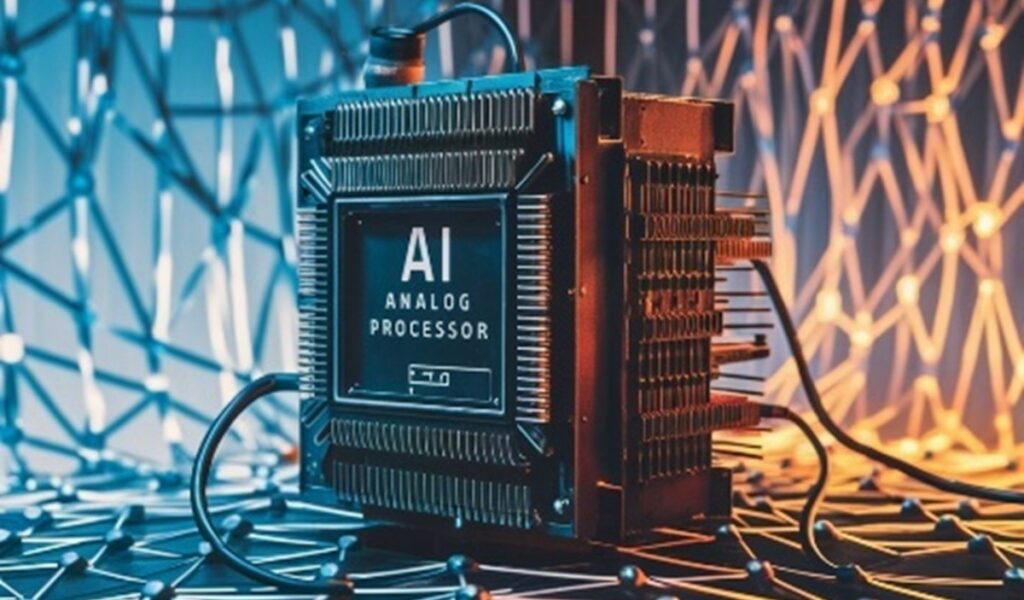
Bits are in pieces

Analog computing makes a surprising comeback
- Dateline
- 18 February 2028
While fashion operates in cycles, technology inevitably moves forward. Copper wires gave way to glass fibre, landlines were replaced by cell phones, and the horse and cart was ousted by the automobile. But within certain niches, technology can behave a bit more like fashion and make a remarkable return.
The resurgence of vinyl records is a classic example. After peaking in popularity, vinyls dipped to next to nothing in the 1990s. By 2023 vinyl had spun its way back to account for 40% of US album sales (though still only 8% of total music revenues). This phenomenon isn’t unique to vinyl. Mechanical watches, typewriters, and even ‘dumb phones’ have all ridden the same rollercoaster from ubiquity to obscurity and back.
Now, it seems analog computing is also getting its groove back. As machine learning – and more specifically, neural networks – evolve at breakneck speed, companies are racing to develop larger, faster, and smarter AI technologies. But speed and intelligence come at a high price. Training these models demands a tremendous amount of computing power, energy, and cooling. And once trained, deploying them to the consumer continues to burn up resources.
Aside from the rising costs, these developments are constrained by the laws of physics. Moore’s law is reaching its limit as transistors get close to a single atom in size. Additionally, Amdahl’s law highlights that due to the sequential nature of digital computing, with separate ‘compute’ and ‘data’ sections on chips, there will always be some delay regardless of the number of processors added.
Analog computing sidesteps these hurdles. It typically operates in parallel, slashing the delays of sequential processing and is significantly more energy efficient than its digital counterpart – by some estimates, up to a thousandfold. But these benefits come with their own downside: they tend to be less precise than binary systems.
Yet is pinpoint accuracy always necessary for every task? What if we could blend the best of both worlds: the precision of digital and the efficiency and speed of analog? Several firms have already started on this path. IBM revealed its analog in-memory compute chip in 2023, and multiple startups are developing low latency, low power, cost-effective analog AI processors for edge computing.
The resurgence of these ‘zombie’ technologies brings its own set of challenges and, therefore, opportunities. The skills, supply chains, and infrastructure once dedicated to analog computing have dwindled, making them rare and valuable resources. Much like how the revival of vinyl records has spurred demand for new turntables and the redevelopment of record-pressing plants, anyone who possesses analog know-how or can innovate to bridge the old with the new can command a premium.
Links to related stories
- Why the Future of AI & Computers Will Be Analog – Undecided, 9 April 2024
- IBM’s Analog AI Chip Takes New Approach to Mixed-signal Architecture – All About Circuits, 14 August 2023
- Vinyl cars make a comeback - Mindbullets (Dateline: 28 April 2029)
- Power struggle: Crypto vs Chatbots - Mindbullets (Dateline: 25 April 2027)
- You can't play it again, Sam - Mindbullets (Dateline: 3 November 2030)
Warning: Hazardous thinking at work
Despite appearances to the contrary, Futureworld cannot and does not predict the future. Our Mindbullets scenarios are fictitious and designed purely to explore possible futures, challenge and stimulate strategic thinking. Use these at your own risk. Any reference to actual people, entities or events is entirely allegorical. Copyright Futureworld International Limited. Reproduction or distribution permitted only with recognition of Copyright and the inclusion of this disclaimer.